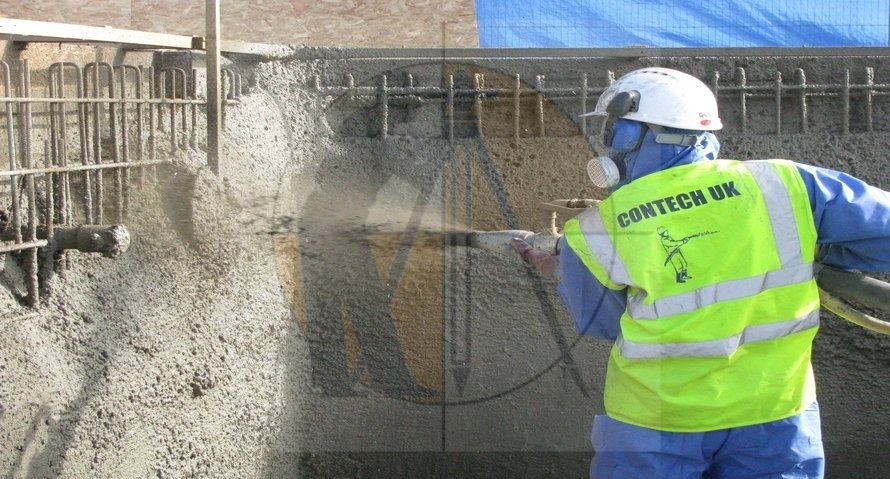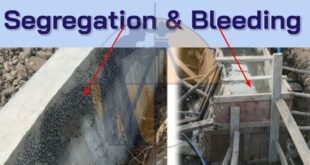What is Sprayed Concrete in Concrete Construction

Sprayed concrete is also called gunite or shotcrete is used for rapid concrete construction. Properties, materials and applications of sprayed concrete are discussed.
Stabilization and support for the structures can be attained with the best quality and performance with the help of an innovative construction technique, called the “sprayed concrete”.
The method of sprayed concrete makes use of man, machine, and concrete. This is a high – performance material, where the person who is assigned as the nozzle-man for this purpose must gain great skill and dedication in the application.
A complete rely on the machine and the sprayed concrete is ensured, as this is a ” three-component success”, i.e. man, machine, and concrete. The quality and the interaction between these three materials govern the ultimate strength and the performance of the sprayed concrete.
It is a flexible, economic, and rapid construction method that requires mechanization at a higher rate and works who are trained or specialized in the same.
History of Sprayed Concrete
Concrete accounts to be more versatile construction material, that is strong and benefitted more massive structures. The fluidity of concrete, before it starts setting, helps to attain any required shape. The only drawback is that we must bring formworks or shuttering works with respect to the shape the structure must take.
In 1895, the curator Dr. Carlton Akeley was looking for a device that will help in making models of prehistoric animals. Even if the skeleton shape could be formed, it was difficult to make the mortar to take that shape with the convention method.
For this, a device was developed by Dr. Akeley to facilitate the spraying of the mortar mixture. A single chamber pressure vessel was developed, that contained a mixture of cement, sand, and water.
When the vessel is pressurized with compressed air, the mix will be sprayed out through a nozzle. A water spray was inbuilt inside, as when the cement and sand are pressurized they get hydrated at the water spray area and come out as a mortar mix. This equipment is called the “cement gun“. This system works based on the “dry mix process“, as the dry miss is hydrated separately.
This was later altered by the “true gun method“. The true gun method initially mixes all the three elements, i.e. the cement, sand, and water before being pumped. This system hence makes use of the “wet process“.
Sprayed Concrete Vs. Shotcrete
The sprayed concrete is also called as the Gunite. In some areas, the sprayed concrete is also called as Shotcrete. But the Shotcrete is designated as a mix that has aggregate with a maximum size of 10mm.
Properties of Sprayed Concrete
When compared to the poured concrete, the sprayed concrete gain certain properties that make it unique and superior. The properties that are obtained uniquely is because of the different methods that are employed for mixing, transporting, and placing rather than the component materials that are used.
The properties of sprayed concrete based on the following are explained below:
1-Water-Cement Ratio
2-Strength
3-Density and Permeability
4-Freeze and thaw resistance
5-Adhesion and Bond Strength
6-Thickness
Learn More
Column Reinforcement Detail | Lateral Reinforcement for Columns | Steel Reinforcement
1-Water Cement Ratio of Sprayed Concrete
The sprayed concrete possesses a water-cement ratio that is lesser than a conventional poured concrete. This condition is seen more in the dry process, where sagging is avoided by a lower water-cement ratio. In the case of a wet process, this low value of the water-cement ratio is obtained with the help of a plasticizer.
2-The Strength of Sprayed Concrete
It is observed that the sprayed concrete can gain higher compressive strength at an early stage, by employing a lower water-cement ratio. The compaction of the sprayed concrete mass is carried out by spraying at a higher velocity. Hence compaction tends to increase the strength. When using batched materials, rapid strength gain is achieved. It is accounted that 30 % higher strength than the poured concrete is obtained for the sprayed concrete.
3-Density and Permeability
As mentioned above, compaction of the mix is employed by the high-velocity application. This compaction makes the mix dense and free from voids. This will decrease the permeability of the sprayed concrete structure.
4-Freeze and Thaw Resistance of Sprayed Concrete
The problem of freezing and thawing exists with an increase in permeability. As in the case of sprayed concrete, we have high impermeability property that makes them resistant to freezing and thawing problems. This will help in the reduction of crack formation and propagation.
The resistance in terms of abrasion is also increased due to its watertight property. Using fiber-reinforced concrete will contribute more to the sprayed concrete resistance properties.
5-Adhesion and Bond Strength
The sprayed concrete facilitates good bonding and surface tension with the substrate. This property of sprayed concrete will reduce the use of bonding agents or coatings, except in certain conditions.
6-Sprayed Concrete Thickness
The fluidity of sprayed concrete makes it be sprayed at higher speed and volumes. After excavation, the tunnel linings or the retaining wall lining can be immediately sprayed with the lining mass.
In the USA, walls that have a thickness of 1 m have been constructed with reinforcement provided at a higher density. The application of sprayed concrete in multiple thicknesses will help in the reduction of thermal stresses in the construction.
Other Post
-
-Concrete Test: Slump test, compression test, split tensile test, soundness etc.
-
-Soil Test: Core cutter test, compaction test, sand replacement test, triaxial test, consolidation test etc.
-
-Bitumen Test: Ductility test, softening point test, gravity test, penetration test etc.
 Surveying & Architects A unique platform of Civil Engineering
Surveying & Architects A unique platform of Civil Engineering
